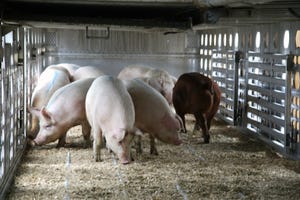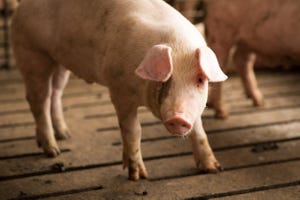Growing Griess Farms
Real-time data collection, that every employee is able to see on digital record, allows for projections of pig growth to happen faster.
November 22, 2023

By Isabella Rivera, SwineTech
Griess Farms is a Nebraska family business passing onto its third generation, and Nathan Griess as part of the family tells its story. Griess specializes in managing the sow farms but also acts as a manager on various Griess Farms facilities and is constantly working to uphold his family’s hands-on approach to excellent pork production.
Home-grown history
Griess Farms began with Nathan’s grandfather, Curtis Griess, and was eventually passed down to Nathan’s father, Dr. Les Griess. Nathan recalls that Les was just four years old when he assisted his first sow, and Nathan’s earliest memory is standing outside finishing barns and spraying down bin pads; you could say it’s something that runs in the family. The first farm in the family, a small facility raising pigs in dirt lots, started in the ‘70s. However, the business grew throughout the ‘80s to do more farrowing and finishing and just kept expanding through the ‘90s and 2000s.
During high school, Nathan spent his summers helping out at their Milford farm, where he learned farrowing, breeding processes and everything in between. He eventually headed off to the University of Nebraska-Lincoln to major in Animal Science and Production Management, and for a time, he was unsure what to do with the degree. He looked into working with other livestock and farming locations outside of the Midwest, but as his collegiate career went on and Nathan received job offers from different corporations, he still felt his family’s pork production calling him back home.
Though it took some effort to convince his parents to let him come back before exploring other fields, Nathan eventually rejoined Griess Farms. He has always felt it was the right choice, particularly with the culture they try to spread throughout their business.
“Especially with a family farm setting, you don’t really get lost in a big corporation," Nathan says. "Everybody has a name and a face…I know everybody who works for us, and they know me, and we have a good relationship…I value that very highly.”
Nathan, who graduated in 2019, spent his first two years at his family’s homestead farm, which they bought from his uncle and have transitioned into a new model. Of his experience with that transition, Nathan credits his father for being the source of much of his learning, especially about medication, breeding pigs and reading the signs the animals in a facility are giving you. “The hands-on experience really opens your eyes,” Nathan affirms.
As far as farm structure within Griess Farms, Nathan says that part of the reason he feels Griess Farms is successful is because they have skilled workers in key positions, and of their people at the top of the chain of command, there are plenty of positive attitudes that trickle down to employees. “Without them, it would look a lot different,” Nathan admits.
Current changes
The past few years have been difficult for the pork industry while fighting issues like tough input costs and biosecurity concerns, and Griess Farms has felt that strain alongside many other producers. The farm is, however, always seeking to improve, no matter how rocky the road looks.
Some of the key areas Griess Farms has sought to expand in are communication between management and other employees, managing new hires, and finding ways to improve efficiency. To do this, the farm has made use of more technology within barns such as PigFlow.
Griess Farms has many employees with J-1 visas who have come to their facilities without having managed hundreds of animals at a time before, and increased use of technology, such as phones and mobile apps that have task lists, instructions and messaging features to ask for help, allows for an accelerated learning curve.
Additionally, the inclusion of more technology in their barns allows the farm to minimize language barriers via translation features, and task lists allow team members to know what they should be doing at all times instead of wandering through barns looking for supervisors, an endeavor that can be both time-consuming and a concern when trying to contain biosecurity risks.
As far as efficiency, more tech has also allowed for the elimination of physical sow cards, which simultaneously eliminates the need to transfer information from paper to a computer—risking data getting lost in the process. Nathan specifically notes that, in late farrowing, the use of technology in barns helps him map out the process of shuffling sows based on where he has empty crates and different nurse sows. This process of mapping and precise, real-time data collection that every employee is able to see on digital record then allows for projections of pig growth to happen faster, another important element of their farrow-to-wean facilities.
Even regarding medical care, Nathan notes that using different mobile features to flag litters or sows for inspection and then also record all the relevant information about their well-being allows a team to maintain cohesion with care instead of worrying about organizing treatment cards.
Nathan did note that the transition process for including more technology in barns can look different from location to location. Facilities with younger employees seemed to adapt faster than older teams less used to tinkering with tech, but he stressed that if the leaders in a barn can pick up new programs, the rest of a team will follow suit.
Pork production is an art passed down through generations, and though it is something that will continue to change over time, the dedication and hard work that goes into the industry remains the same. Nathan and Griess Farms are just one example of how a well-maintained family business continues to support the pork industry that we know today.
You May Also Like



